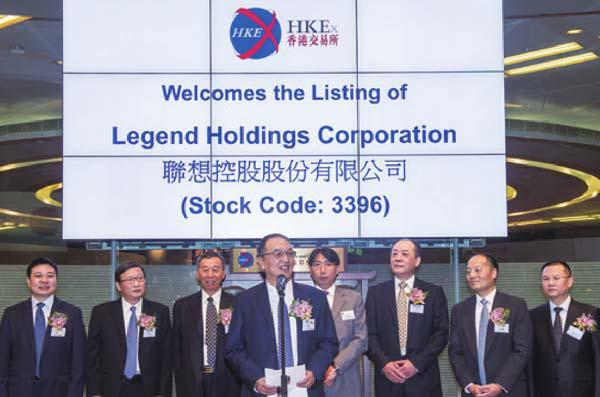THE FABULOUS FIVE
2018-01-15ByYanYing&YouShanshan
By Yan Ying & You Shanshan
Its November 27, 1978. “Liu Chuanzhi, then a 34-year-old researcher at the Institute of Computing Technology of the Chinese Academy of Sciences, gets to work on time. Before stepping into the office, he picks up a thermos bottle filled with hot water from the reception area, makes casual jokes with the senior doorkeeper and picks up a copy of Peoples Daily from his mailbox. Normally, he will idle his entire morning reading the paper and drinking tea until lunch time.”
This paragraph about Liu comes from the book Thirty Years of Chinese Business by Chinese writer Wu Xiaobo. Six years later, Liu founded Lenovo, which was to become a giant enterprise.
The year 1978 is crucial in Chinas contemporary history: The curtain on reform and opening up was raised that year. The planned economic system was gradually replaced and entrepreneurs began to emerge. Within 40 years, China made a transformation that took Western countries more than 100 years to accomplish, making it a vibrant and increasingly powerful world player.
Emerging enterprises
For Liu and his contemporaries, the first years of reform and opening up meant innovation and transcendence. New things emerged and industrious attempts could lead to success. The development of enterprises in China not only se t aside the old tradition, but established a new one. Before reform and opening up, China had no business people; it was only after 1978 that this group started to emerge, said Chen Chunhua, a professor at the National School of Development, Peking University, and dean of BIMBA. She has been conducting research on the development of Chinese enterprises.
The year 1984 is also a landmark when township enterprises were officially recognized. Many private enterprises were founded that year, including todays tech giants Huawei and Lenovo.
Reform and opening up entered a further and deeper stage after 1992 with the concept of a “socialist market economy with Chinese characteristics” introduced. Chinese enterprises genuinely engaged in market competition and entered the stage of industrialization. Large manufacturing enterprises came into being and some companies started to cultivate their own brands. Two landmark events happened around 2004. One was Lenovos acquisition of IBMs global PC business, and the other was electronic appliance manufacturer TCL Corp.s acquisition of Frances Thomson Electronics. From then on, Chinese enterprises set up their presence in the international market.
In the past decade, globalization developed rapidly and Internet technology clicked the button on the worlds third industrial revolution, which provided Chinese enterprises with opportunities for “corner overtaking.” Some of them have occupied the leading position in different sectors in the world, such as Huawei, Alibaba and Tencent.
“The miracle created by Chinese enterprises in the past 40 years is very exciting. I am lucky to have been able to witness and participate in this process,” Chen said.
Keys to success
Curiosity about what enabled Chinas industry pioneers to achieve rapid growth and remain competitive pushed Chen to work on this. In 1992, she embarked on research and set 30 years as the research span to track the development of Chinese companies, observing their development patterns and studying whether such patterns could be applied in other countries.
The years between 1982 and 1992 are the data basis for Chens studies. From more than 3,000 companies, Chen selected five, namely, Haier, Lenovo, TCL, Huawei and Baosteel, covering public and non-public firms, and private and state-owned enterprises.
Chen planned to track these enterprises for 30 years, beginning in 1992. She was lucky that these five companies not only survived the first decade, but also the ensuing 16 years and have been among the most outstanding enterprises in the history of Chinese enterprises. “I was always nervous during the follow-up study because if the companies failed to survive, my studies would be in vain,” Chen said.
The success of these enterprises wasnt only a matter of luck. Based on Chens studies, there are four major reasons with strong Chinese characteristics for their achievements.
First, credit goes to their “hero leaders.” “In the early stage of reform and opening up, these groundbreaking leaders were motivated not only by money, but also by the desire to achieve progress in the whole industry,” Chen said.
Liu, who didnt want to spend his whole life merely as a computing science researcher, quit his stable job and founded Lenovo in 1984, eventually making it a global PC giant. Ren Zhengfei, head of Huawei, has a strong spirit of criticism and self-criticism. “There is no success for Huawei, only growth,” Ren said, leading Huawei on the path of innovation and transformation. Zhang Ruimin, President of Haier, successfully transitioned the company from a traditional home appliance manufacturer to a giant in the e-commerce world during the rise of the Internet.

Second, the five companies have created appropriate management methods by learning from foreign experience.
Chen was very impressed when Huawei adopted the management model of IBM in the late 1990s, undergoing a bitter reform. Earlier, Huawei had introduced Germanys management system but it failed after Huaweis localization efforts. So Ren made the resolve not to challenge IBMs approaches, but put them into thorough practice in his company. After the reform, Huawei has gradually changed from a “manufacturer” to an “innovator.”
“With large sums of foreign capital and companies swarming into China, Chinese companies did a good job of integrating their own conditions with Western experience. They knew well Chinese management philosophy, behavioral habits and culture and also adhered to Western standards. Thus, they were able to create unique management methods,” she said.
Third, channel building is key. In the early stage of reform and opening up, Chinese enterprises knew little about branding while facing competition from international brands. But this didnt keep them from working hard on marketing and establishing their own customer base.
Last, Chen factored in a community of shared interests between enterprises, employ- ees and other concerned parties.
Chinese enterprises have formed their own development modes after long-term advances which have not only drawn the attention of Western society, but have also become the target of their research. For many developing countries, these practices can offer a reference for innovation in the era of globalization, Chen said.
Dancing with elephants
Whether Chinese enterprises could compete with centuries-old Western counterparts in the international market was the most exciting part of the past decade in the era of globalization.
The five enterprises that Chen studied have all undergone the process of internationalization and achieved leapfrog growth. In 1996, Huawei started to explore its international market and went through many failures before becoming a Chinese powerhouse and changing the competition pattern of the world telecommunications manufacturing industry.
In 2004, TTE Corp., a joint venture of TCL and Thomson, was officially established. The annual sales volume of the new companys color TVs hit 18.5 million units, making it the largest color TV maker in the world. It also marked the first time a Chinese enterprise had the power to rebuild the world map in a mainstream industry.
But it is no easy task to dance with elephants. Lenovos acquisition of IBMs global PC business enabled it to learn from the American company closely and start its own internationalization. In this process, Lenovo formed an international team, brand and market channels, but also experienced great pains.
After its milestone acquisition, Lenovo went through five years of internationalization trials. It hired an internationalized team directly from abroad but ultimately it failed since Lenovos Chinese strategy couldnt be adapted to the international market. It also faced the pressure of making profits and gaining consumer acceptance in the U.S. market. In the face of all of this, Lenovo didnt retreat, but worked harder to find a development mode. Its conclusion was that Chinese enterprises needed to form their own international teams and cultivate local talent pools to adapt to the constant changes in overseas markets. They should also consolidate their leading position in the Chinese market and rely on it to expand their global presence.
In her book C-Theory, Chen wrote, “When the Chinese business world was like a thorny wilderness, we needed ambitious dreamers and pioneers. Now as Chinese enterprises take their place on the worlds stage, we need more responsible creators.”
